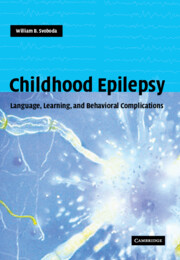Book contents
- Frontmatter
- Contents
- Preface
- Glossary
- 1 Looking ahead
- Part I Speech and language problems
- 2 Language: the challenge
- 3 Speech, language, and communication
- 4 Speech and language problems in epilepsy
- 5 Seizure types and speech and language risks
- 6 Language regression with epilepsy syndromes
- 7 Other epilepsy language syndromes
- 8 Seizure-management effects
- 9 Evaluation of speech and language problems
- 10 Management of speech and language problems in epilepsy
- 11 Behavior consequences
- Part II Learning problems
- Part III Behavior problems
- Index
- References
5 - Seizure types and speech and language risks
from Part I - Speech and language problems
Published online by Cambridge University Press: 26 October 2009
- Frontmatter
- Contents
- Preface
- Glossary
- 1 Looking ahead
- Part I Speech and language problems
- 2 Language: the challenge
- 3 Speech, language, and communication
- 4 Speech and language problems in epilepsy
- 5 Seizure types and speech and language risks
- 6 Language regression with epilepsy syndromes
- 7 Other epilepsy language syndromes
- 8 Seizure-management effects
- 9 Evaluation of speech and language problems
- 10 Management of speech and language problems in epilepsy
- 11 Behavior consequences
- Part II Learning problems
- Part III Behavior problems
- Index
- References
Summary
Specific speech and language problems, such as speech arrests, aphasias, paroxysmal word utterances, palilalia, dysarthrias, and unformed vocalizations, are more apt to occur with specific seizure types. Speech and language problems may appear simultaneously with, later than, or occasionally before the onset of the epilepsy. They may occur as part of or as the aftereffects of a seizure. At times, they may be the only manifestation of the seizure. Children appear to be less susceptible than adults to these rarely recognized disturbances, yet a child's speech and language are also susceptible to the effects of a seizure disorder.
Language problems may be brought out by stress, by uncontrolled seizures, by medications, or as seizure aftereffects in a postictal period. Surgery in the area of language functioning may sacrifice language and thus must be carefully localized preoperatively. Language problems are often unrecognized yet they may underlie later learning and behavior problems blamed on the epilepsy. Medication, especially at high doses, may bring out some of these problems.
Symptoms of an ongoing disturbance of speech and language, varying from day to day, must be differentiated from the brief episodic disturbed speech function due to actual seizure attacks and from the aftereffects seen during a recovery period. In chronic speech and language problems, there may be deterioration in the clarity or the smooth flow of speech, in word selection, and in understanding or word order or word sounds when the patient tries to express thoughts.
- Type
- Chapter
- Information
- Childhood EpilepsyLanguage, Learning and Behavioural Complications, pp. 50 - 69Publisher: Cambridge University PressPrint publication year: 2004



